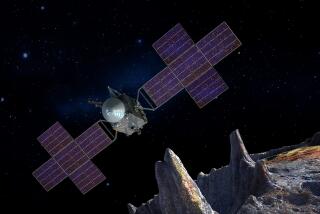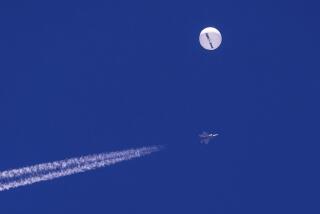Sometimes the Sky Does Fall
- Share via
NASA’s recent reversal of its prediction that an asteroid could hit the Earth in 2030--the second such reversal in two years--might lead many to conclude that the danger of asteroids and comets is more the stuff of movies than real life. In fact, dozens of space objects enter Earth’s atmosphere every day. Most streak harmlessly across the sky as “shooting stars,” more wonderful than frightening.
However, objects 50 meters in diameter, like one that flattened 1,200 square miles of forest in Siberia in 1908, strike the Earth every 100 years on average. The Tunguska asteroid exploded above the Siberian forest in a brilliant blue fireball. Had it arrived five hours later, St. Petersburg might have been destroyed, along with its hundreds of thousands of people.
In 1995 NASA promised Congress that it would have all potentially dangerous objects in space identified by 2005. But a report released in September by a British task force discloses that the space agency is years behind schedule, largely because it has spent only $2 million a year on the project.
British Prime Minister Tony Blair and the European Space Agency are now considering funding the task force’s key recommendation: building the world’s first telescope dedicated to finding threatening comets and asteroids. Astronomers in the United States say they have had trouble overcoming what they call “the giggle factor”--the tendency to snicker at asteroid warnings, viewing them as Chicken Little scenarios.
The British report, however, offers a rational reason for the sort of increased spending that astronomers at NASA have been unable to obtain. It points to a growing body of astronomical research showing that asteroid impacts are statistically more likely to harm humans than some other, more commonly recognized perils. As the lead author of the British report, former European Space Agency Chairman Harry Atkinson, explains, “The risk of cataclysmic asteroid impacts is very small. A one-kilometer asteroid arrives on average every 100,000 years. But if that was the risk of an accident in a nuclear power station, we would spend a lot of money to reduce the risk.”
None of this is to encourage NASA to fund improbable “Star Wars”-like technologies in the highly unlikely chance that they might soon be able to ward off or deflect space objects. Deflection theory was seriously embraced in 1996, when the Air Force quietly carried out a study of options for diminishing the chance of an asteroid impact. One would be to fire explosives or a projectile from an unmanned spacecraft to nudge an asteroid out of Earth’s path; another would be to somehow attach solar sails to an asteroid to change its orbit. At present this is the stuff of fantasy.
The focus now should be on mapping potentially dangerous objects in the solar system. Improved detection would make deflection far more feasible, because the earlier a space object is detected, the less force will be required to change its path. Minimal force would nudge an asteroid out of Earth’s way if the asteroid could be detected and intercepted a year in advance, but phenomenal force would be required for an object only two months away.
Deflecting space objects may still be more a premise for a Bruce Willis movie than a technologically feasible priority for Congress, but detection should be an urgent priority now.
More to Read
Sign up for Essential California
The most important California stories and recommendations in your inbox every morning.
You may occasionally receive promotional content from the Los Angeles Times.










